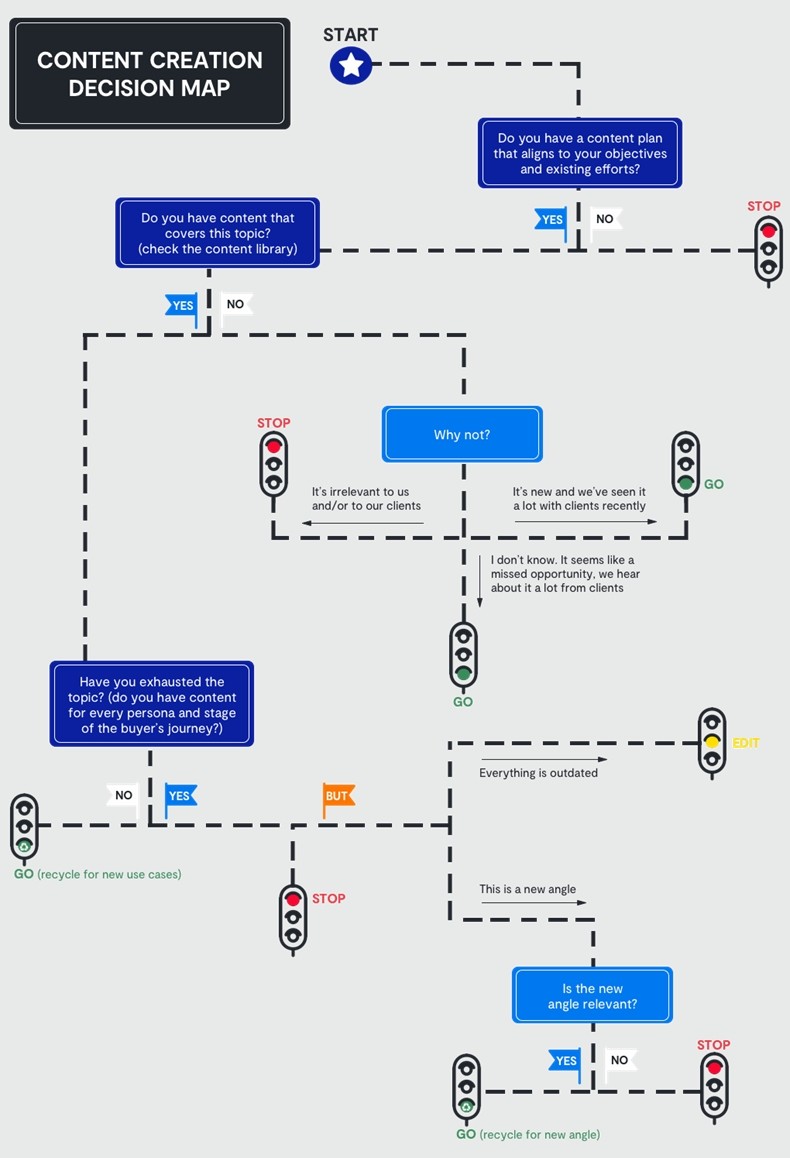You need a lot of content. We're talking an order of magnitude in the league of Law & Order and The Simpsons. But before you guzzle a gallon of coffee and tie a bandana around your forehead Karate Kid style... stop.
There is such a thing as too much content. And if you're creating content for the sake of it (without a clear business need, or to simply create something new), you've taken a wrong turn.
The Content Paradox: Not Enough or Too Much?
It's a fine line between not having enough content and having too much content.
On the one hand, you need enough content to satisfy various use cases. Consider Forrester's finding that a person on average consumes 11.4 pieces of content before buying.
In practice, I've seen firsthand how that number can grow when your business sells more complicated or expensive products that have long sales cycles. Then factor in the need to create content for different personas, buyer journey stages, product lines, times of year, and consumption preferences—not to mention the need to keep all that content fresh—and it's enough to make your head spin.
On the other hand, having too much content creates challenges. When you have too much content, it becomes difficult to manage—i.e., ensure it remains relevant and on-brand and gets used properly within campaigns. And if content doesn't get used properly, then buyers will typically end up requiring more content than they already do throughout the purchase process. (Those challenges aside, a 2018 study by Content Marketing Institute and LinkedIn found that as much as 80% of Marketing's content goes unused by Sales, which means a lot of wasted effort.)
So where is the line between not enough and too much content? When you begin creating content for the sake of creating more content.
When that happens, you typically end up creating new content while maintaining older content that has become outdated—instead of simply refreshing or retiring it—or you create content that doesn't tie directly to business outcomes.
The Goldilocks Problem: How to Find the 'Just Right' Amount of Content
Creating content is certainly a bit of a goldilocks situation, but it is possible to walk the line between not enough and too much.
So how do you find the "just right" amount of content? Start with these six steps.
1. Start with the "why" and align your content to business objectives
When you think about creating a new piece of content, always start with the "why" (and absolutely never start with the "what").
If someone asks for "a new whitepaper" or "a flashy infographic," dig into why they want that specific piece of content. By asking questions that get to the heart of the "why" in these situations, I have found that even when a sound reason for creating the content exists, the best way to meet the need doesn't always match the original ask.
Understanding the "why" makes it easy to decide whether you need the content and, if so, what form that content should take.
Going one layer deeper, you also need to align content to your business objectives to ensure that anything you create is relevant to both your target audience and your business. For example, if your audience cares about creating GIFs but your business can't help them do that, then you shouldn't develop content on that topic. Sure, the GIF-related content might drive traffic, but if that traffic doesn't translate to actionable leads for your sales team, then it's useless traffic.
Specifically, content should serve at least one of four purposes:
- Position your company as a thought leader: Boost overall awareness about and trust in your business
- Attract and convert new leads: Engage new prospects for your business and convert them from anonymous to known visitors
- Nurture existing leads and customers: Maintain stickiness with existing leads and customers to strengthen the relationship and continue to build trust
- Accelerate pipeline: Improve the speed at which prospects move through your sales pipeline by allowing them to self-nurture
2. Keep track of existing content
Once you start creating and publishing content, it can be easy for that library to spiral out of control—even if you start with the "why" and align it to business objectives. The best way to avoid that death spiral is to keep track of what you have.
To do so, you need a central location where you can house all your content and pertinent information on each piece: where it's published, when it was published, when it was last updated, what the topic is, what audience it's for, etc. (A great tool I use for this purpose is AirTable, which offers a sortable spreadsheet that makes it easy to filter for content that fits any combination of parameters. Here is a sample of what that can look like.)
With this type of tracking in place, you can easily understand what content you already have and what gaps exist in your content library. That understanding is important for two main reasons:
- When a need for new content arises, you can easily determine whether you already have content that satisfies the need or whether you should create something new.
- You can easily identify outdated content that should either be either refreshed to stay relevant or retired and taken out of circulation.
3. Reduce, reuse, recycle: Use what you have before ever creating something new
Beyond simply using an existing piece of content as is, you can think about ways to recycle it into spinoff pieces of content. Recycling content allows you to expand the life of a single piece of content by using it in ways that keep it fresh and appeal to different audiences.
Here are three ways to recycle your content into spinoff pieces:
- Repackaging content into another format to appeal to audiences with different consumption preferences (e.g., turning a webinar into a guide)
- Taking smaller chunks of a large piece of content and using them to pique interest in and promote the anchor piece of content (e.g., turning an e-book into a few blog posts, all of which have a CTA to download the e-book)
- Tailoring a single piece of content for different audiences or buyer journey stages (e.g., turning a tactical guide into a strategic overview for a more senior audience, or simply highlighting different elements within the same piece of content when promoting it)
4. Enforce the guardrails
Knowing what you should do is one thing. Actually doing those things is quite another. To be successful, you need to enforce the guardrails outlined here. One of the best ways to do so is by using a content creation decision map like this to help ensure that you always think through the "why," confirm you don't already have content that satisfies a need and recycle before creating something net-new.

Don't Fear the Content Beast
You will always need new content to feed the conent-demand beast: New product developments will crop up, your audience's needs will change, and you'll have to refresh outdated content. But what sets truly powerful and efficient content marketing programs apart is the ability to feed that beast without going overboard.
Doing so isn't always easy, but it is possible; and it all starts with tying all content to specific business objectives and reusing what already exists in every possible way before ever creating something new.




